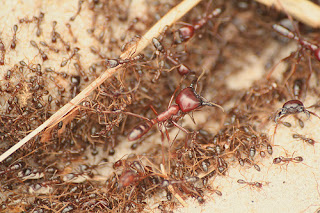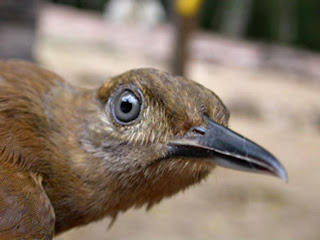Army-ants storm through the jungles of Panama a million strong devouring any and every living creature in their path. Some clever birds have found a way to capitalize on the mayhem: Stay close to the ants and eat the leaping, running, and scampering insects that attempt to escape.

Who would want to escape from this love fest?
Antbirds and ovenbirds, the main ant-following species, have different strategies for using the ants to their advantages. Some birds only follow the ants within their own territories, but stop when they reach the borders. Others dabble in ant following, hitting them up for an easy meal but supplementing this by foraging on their own. Finally, the true loyalists rely solely on the ants to scare up their prey.
One species of ant-following antbird in the Thamnophilidae genus
Rob Brumfield, an Assistant Curator of Genetic Resources at the Museum of Natural History at Louisiana State University has studied the ant-following birds' behavior.
He describes the process of locating army-ants in the dense jungle: "I can hear in the distance the snap, crackle and pop of a million marauding army-ants marching through the leaf litter. They are consuming every insect, spider and lizard in their path. And traveling with the army-ants is a boisterous flock of birds."
Army-ants are routinely found in the birds' stomach contents, but scientists are split on whether or not the birds intentionally eat the army-ants or if the ants just happen to be attached to the prey.




